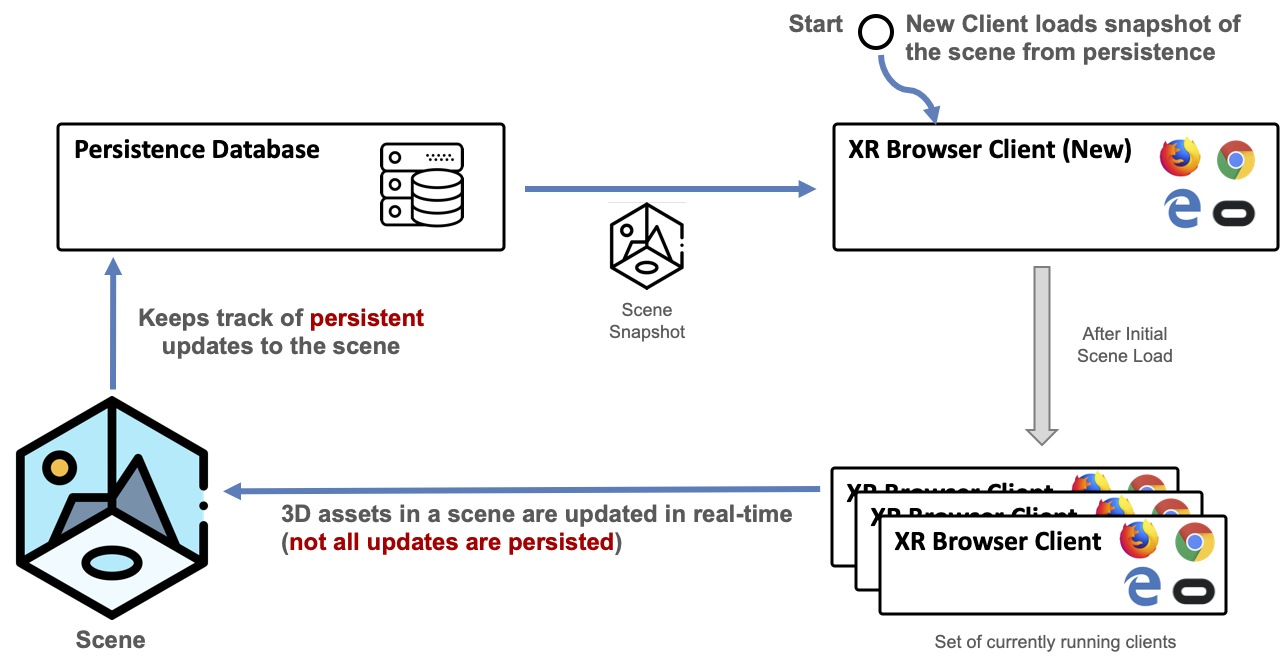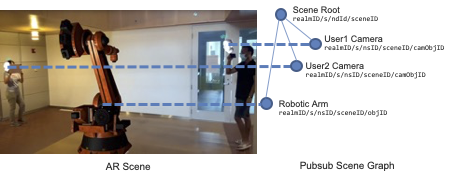ARENA Scenes
ARENA scenes include 3D content, configuration parameters, applications with shared end-points that allow users’ interactions, and information about markers that might serve as location anchors to the Scene. Scenes exist within a tree-like hierarchy with configurable access control and are often attached to a physical location. Using a web analogy, the Realm is like a (local) webserver and the Scene is like a particular web application at a URL endpoint.
Scene Objects
ARENA scenes are a collection of Entities to which Components can be attached, following A-Frame’s Entity-Component-System (ECS) architecture. We support the majority of A-Frames’s primitives (e.g., geometries like boxes, circles, spheres) and components (attributes that can be attached to objects, such as position, rotation, material, sound). We also added ARENA-specific components for AR markers, programs, networked events, and options. All ARENA objects have well-defined JSON schemas, which are the basis for the over-the-wire JSON message format shown below (Figure 2) and are transmitted over the PubSub.
{
"object_id": "abox",
"persist": true,
"type": "object",
"action": "create",
"data": {
"object_type": "box",
"depth": 1,
"height": 1,
"width": 1,
"position": { "x": 1, "y": 1, "z": 1 },
"rotation": { "x": 0, "y": 0, "z": 0, "w": 1 },
"armarker": {
"lat": 40.4432,
"lon": 79.9428,
"markerid": "1",
"markertype": "apriltag_36h11",
"size": 150,
"ele": 200
}
}
}
Figure 2. Example Message and Object Definition.
All messages have an objectid, type, and an action (create, update, delete). Attributes in data are the object’s-specific attributes and components. The example shows a box geometry with depth, height and width attributes, position and rotation components, and an ARENA-specific ARMarker component. A web interface developed to make simple edits to a scene, shows an editable scene object list, which can include scene options, programs, lights and 3D geometries and models. We imagine more advanced interfaces could be developed to create scenes, and have already some prototype editors for VR/AR.
Scene Loading
Scenes are loaded akin to web applications within a web browser. However, unlike most standard web browsers, it is possible to simultaneously view a composition of multiple scenes without switching between tabs. In XR, a user might have access to one or more scenes in the same physical area that can be layered within an XR browser session. When the Scene is loaded, its current state is fetched from a data store service that tracks the persisted state of the Scene (see Figure 3). Compositing scenes together in a single view approximates how people naturally interact with the physical environment (as opposed to manually switching tabs).
 Figure 3. Scene objects are first loaded from a data store service and then updated over PubSub.
Figure 3. Scene objects are first loaded from a data store service and then updated over PubSub.
Real-time Updates
Once loaded, each of the 3D assets in a scene are then updated in real-time over the Realm’s local PubSub bus (see Figure 3). For example, if an application changes the color of a cube, this would be captured in a message over the bus. Figure 4 below exemplifies how a 3D scene is represented.

Figure 4. Objects in an ARENA Scene are implicitly networked over a PubSub bus, where each object is controlled by a topic end-point. The topic hierarchy is partitioned by Realm (RealmID), owner name space (nsID), scenes (sceneID) and objects within the scene(camObjID or objID).
Each object in a Scene is managed by a topic end-point on the PubSub bus, making them implicitly networked. When a user moves their camera or clicks on an object, these updates and events are transmitted as messages. This network transparency allows any number of applications and users running from different devices to interact seamlessly within the 3D environment. As shown in Figure 4, users can see an avatar representation of other users in AR/VR as their camera pose is being published. See more details about the ARENA PubSub structure.
Access Control
Each user is given a token which defines read/write access to topics within the scene structure. This mechanism allows for very granular control over the objects in a scene. For example, we can make certain objects invisible to a user by not granting read ac-cess to that particular object in the PubSub structure. For simplicity, we currently use scenes as our basic unit of access control. We have defined two basic roles for users in a scene: editor and viewer. See more details about the ARENA PubSub access control.